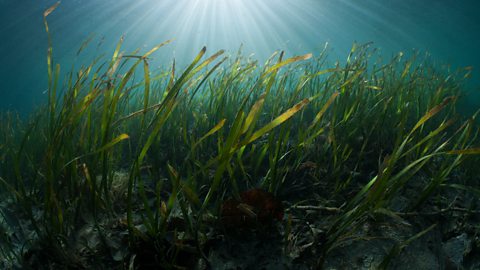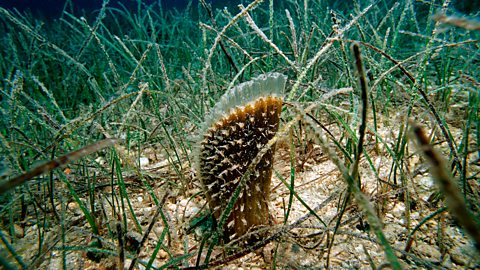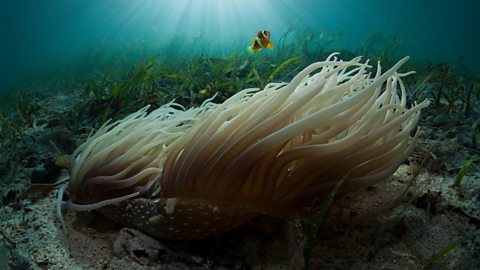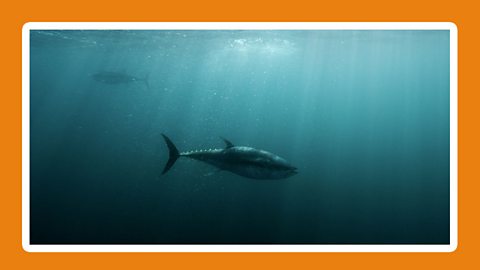
Introduction
This may look like a very ordinary marine plant, but did you know that seagrass actually has climate change reversing superpowers?

This humbleLow in rank, importance or status. grass, which grows along the ocean bed, has been described as a âwonder plantâ. It has the amazing ability to absorb carbon dioxide gas from the atmosphere.
Scientists have discovered that seagrass has a vital role to play in the battle to reverse climate change.
Why is this important?
Our planet is heating up. This is known as global warming. Carbon dioxide is one of the gases which contributes to this process.
It is known as a greenhouse gas, this means that it traps heat in the Earthâs atmosphere. As these greenhouse gasses build up they form an invisible âblanketâ that traps heat from the Sun. This is causing temperatures to rise here on Earth and is making our weather more unpredictable and extreme.
What can we do about this?
We need to reduce the amount of carbon dioxide that we release into the atmosphere. This is called reducing our carbon footprint. We can do this by reducing the amount of fossil fuelFuel which can be burned for energy made from decomposing plants and animals. such as oil, coal and gas that we burn.
We also need to reduce the amount of carbon dioxide gas that already exists in our environment. This is why trees and other plants are so important. They absorb carbon dioxide from the atmosphere, store the carbon and release oxygen back into the environment.
The Earth's lungs
The Amazon rainforest in South America is often described as the lungs of our planet. This is because of its ability to absorb so much of the Earthâs carbon dioxide and to produce oxygen.
The trees absorb carbon dioxide from the atmosphere and release oxygen into the environment.
What about seagrass?

Just like trees and plants on land, seagrass can absorb huge quantities of carbon dioxide from the ocean. It stores the carbon and releases oxygen back into the environment.
But seagrass also has a superpower. It can absorb huge amounts of carbon dioxide. Each year seagrass absorbs as much as 10% of the oceanâs carbon dioxide.
The same area of seagrass can absorb 35 times as much carbon dioxide as an area of tropical rainforest.

These seagrass beds also provide the perfect habitat, or home, for thousands of different species of animals.
Seagrass super-powers
- Seagrass can take carbon out of the atmosphere around 35 times faster than tropical rainforests.
- Seagrass produces oxygen.
- Seagrass is an important underwater habitat for thousands of different species of animals.
But this incredible underwater habitat is under threat. In the UK researchers believe that around 92% of our seagrass has been lost during the last century, or hundred years.
Seagrass is now critically endangered, that means action must be taken to ensure that seagrasses do not become extinct. Across the world, communities of scientists are working hard to make sure this doesnât happen.
Project Seagrass

In Wales a team of scientists are determined to help the seagrass beds recover. They are working hard to collect over a million seagrass seeds and to replant them in Dale, Pembrokeshire.
Marine biologists are busy replanting seagrass shoots. Soon they hope the area will be a thriving seagrass meadow, like a carpet on the ocean floor soaking up tonnes and tonnes of carbon.
Video: Seagrass meadows, an important underwater habitat
Watch the Project Seagrass team as they replant seagrass to help slow down climate change.
What can you do?
We can all make a difference and help reduce the amount of carbon dioxide in the atmosphere.
- Plant a tree at home or in school.
- If it is safe and practical to do so, why not walk or cycle to school?
- Turn off lights and electrical devices.
Quiz: How can seagrass help slow down climate change?

Where next?
How will climate change impact the seaside?
Learn about greenhouse gases, global warming, and melting ice caps and their impact on the village of Fairbourne in north Wales.

What predators are in the Celtic Sea?
Learn about the different species of wildlife in the deep oceans around Wales.

KS2 Sustainability
A collection of lessons for pupils aged 7 to 11

More on Climate
Find out more by working through a topic
- count2 of 2
